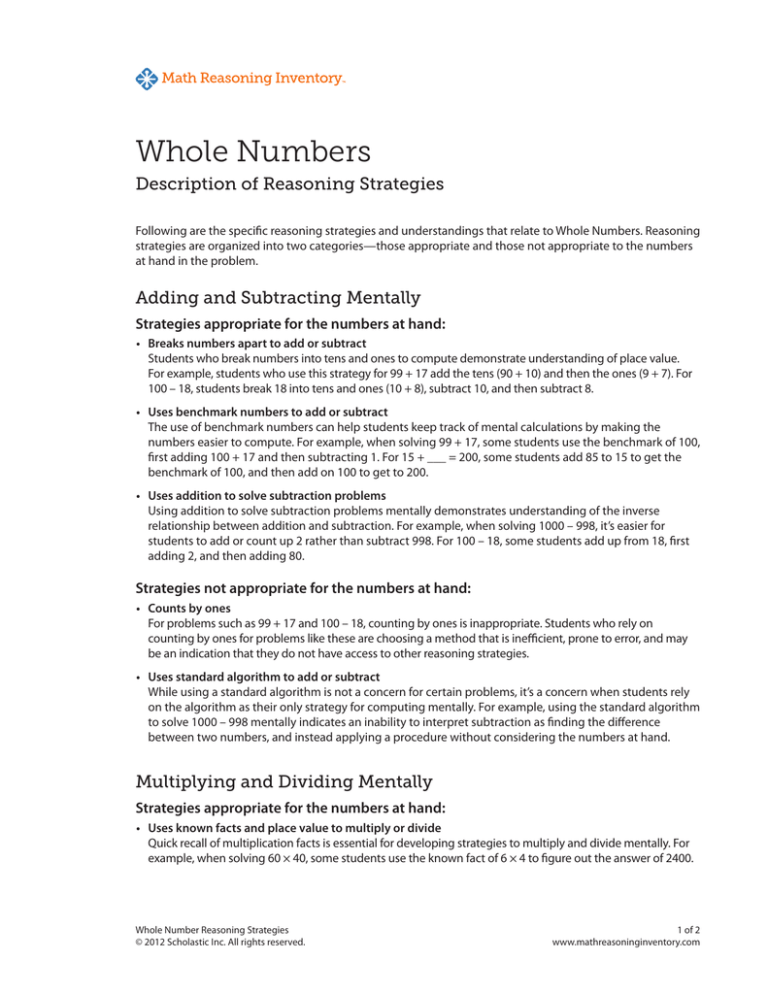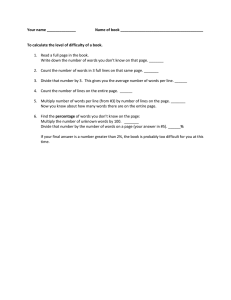
Whole Numbers
Description of Reasoning Strategies
Following are the specific reasoning strategies and understandings that relate to Whole Numbers. Reasoning
strategies are organized into two categories—those appropriate and those not appropriate to the numbers
at hand in the problem.
Adding and Subtracting Mentally
Strategies appropriate for the numbers at hand:
• Breaks numbers apart to add or subtract
Students who break numbers into tens and ones to compute demonstrate understanding of place value.
For example, students who use this strategy for 99 + 17 add the tens (90 + 10) and then the ones (9 + 7). For
100 – 18, students break 18 into tens and ones (10 + 8), subtract 10, and then subtract 8.
• Uses benchmark numbers to add or subtract
The use of benchmark numbers can help students keep track of mental calculations by making the
numbers easier to compute. For example, when solving 99 + 17, some students use the benchmark of 100,
first adding 100 + 17 and then subtracting 1. For 15 + ___ = 200, some students add 85 to 15 to get the
benchmark of 100, and then add on 100 to get to 200.
• Uses addition to solve subtraction problems
Using addition to solve subtraction problems mentally demonstrates understanding of the inverse
relationship between addition and subtraction. For example, when solving 1000 – 998, it’s easier for
students to add or count up 2 rather than subtract 998. For 100 – 18, some students add up from 18, first
adding 2, and then adding 80.
Strategies not appropriate for the numbers at hand:
• Counts by ones
For problems such as 99 + 17 and 100 – 18, counting by ones is inappropriate. Students who rely on
counting by ones for problems like these are choosing a method that is inefficient, prone to error, and may
be an indication that they do not have access to other reasoning strategies.
• Uses standard algorithm to add or subtract
While using a standard algorithm is not a concern for certain problems, it’s a concern when students rely
on the algorithm as their only strategy for computing mentally. For example, using the standard algorithm
to solve 1000 – 998 mentally indicates an inability to interpret subtraction as finding the difference
between two numbers, and instead applying a procedure without considering the numbers at hand.
Multiplying and Dividing Mentally
Strategies appropriate for the numbers at hand:
• Uses known facts and place value to multiply or divide
Quick recall of multiplication facts is essential for developing strategies to multiply and divide mentally. For
example, when solving 60 × 40, some students use the known fact of 6 × 4 to figure out the answer of 2400.
Whole Number Reasoning Strategies
© 2012 Scholastic Inc. All rights reserved.
1 of 2
www.mathreasoninginventory.com
• Breaks numbers apart to multiply or divide
Using the distributive property is an extremely useful strategy for mental computation. Numbers can be
broken apart in different ways. For example, when solving 15 × 12, some students break the 15 into 12 + 3,
multiply 12 × 12 and 3 × 12, and then add 144 + 36. Other students break 12 into its place value parts of
10 + 2, multiply 15 × 10 and 15 × 2, and then add 150 + 30.
• Uses benchmark numbers to make estimates
Learning to estimate is as important as learning to perform exact calculations. Estimation can be used
to check the reasonableness of answers or to figure out an answer that does not need to be exact.
The strategy of using benchmark numbers to make estimates requires rounding and then computing
mentally. For example, when asked to make an estimate for 18 × 21, students who use this strategy round
both numbers to 20, and then multiply.
Strategies not appropriate for the numbers at hand:
• Uses standard algorithm to multiply or divide
While using a standard algorithm is not a concern for an individual problem, it’s a concern when students
rely on the algorithm as their only strategy for computing mentally. For example, solving 15 × 12 by
visualizing the numbers lined up vertically and using the multiplication algorithm is inefficient and may
indicate a lack of being able to numerically reason.
• Figures exact answer to estimate
Learning to estimate is as important as learning to perform exact calculations. Estimation can be used to
check the reasonableness of answers or to figure out an answer that does not need to be exact. Relying on
figuring exact answers when estimating may indicate a lack of flexibility to reason in other ways with the
numbers at hand.
Applying Understanding
• Models with mathematics to solve problems in context
Solving problems in contexts requires that students can model situations mathematically—relate situations
to the appropriate numerical operations and provide answers that relate to the problem contexts. For
example, to figure out how many buses are needed for 295 students when each bus holds 25 students, some
students round 295 to 300 and figure that 12 buses are needed. Others divide 295 by 25, figure that the
answer is 11 R 20, and use that information to determine that 12 buses are needed.
• Uses inverse relationship of addition and subtraction
Using addition to solve a subtraction problem when appropriate is an indication of understanding
the inverse relationship of addition and subtraction. For example, to solve the subtraction problem
1000 – 998, it’s more efficient to add up from 998 to 1000. Relying on the standard subtraction algorithm
to solve this problem indicates a lack of understanding of this important mathematical property.
• Uses distributive property
Breaking numbers apart to multiply mentally indicates understanding of the distributive property of
multiplication over addition. For example, to solve 15 × 12, some students break apart 12 into 10 + 2, and
then multiply 15 × 10 and 15 × 2. Others break apart 15 into 12 + 3 and multiply 12 × 12 and 3 × 12. Both
of these strategies indicate the ability to apply the distributive property.
Whole Number Reasoning Strategies
© 2012 Scholastic Inc. All rights reserved.
2 of 2
www.mathreasoninginventory.com


